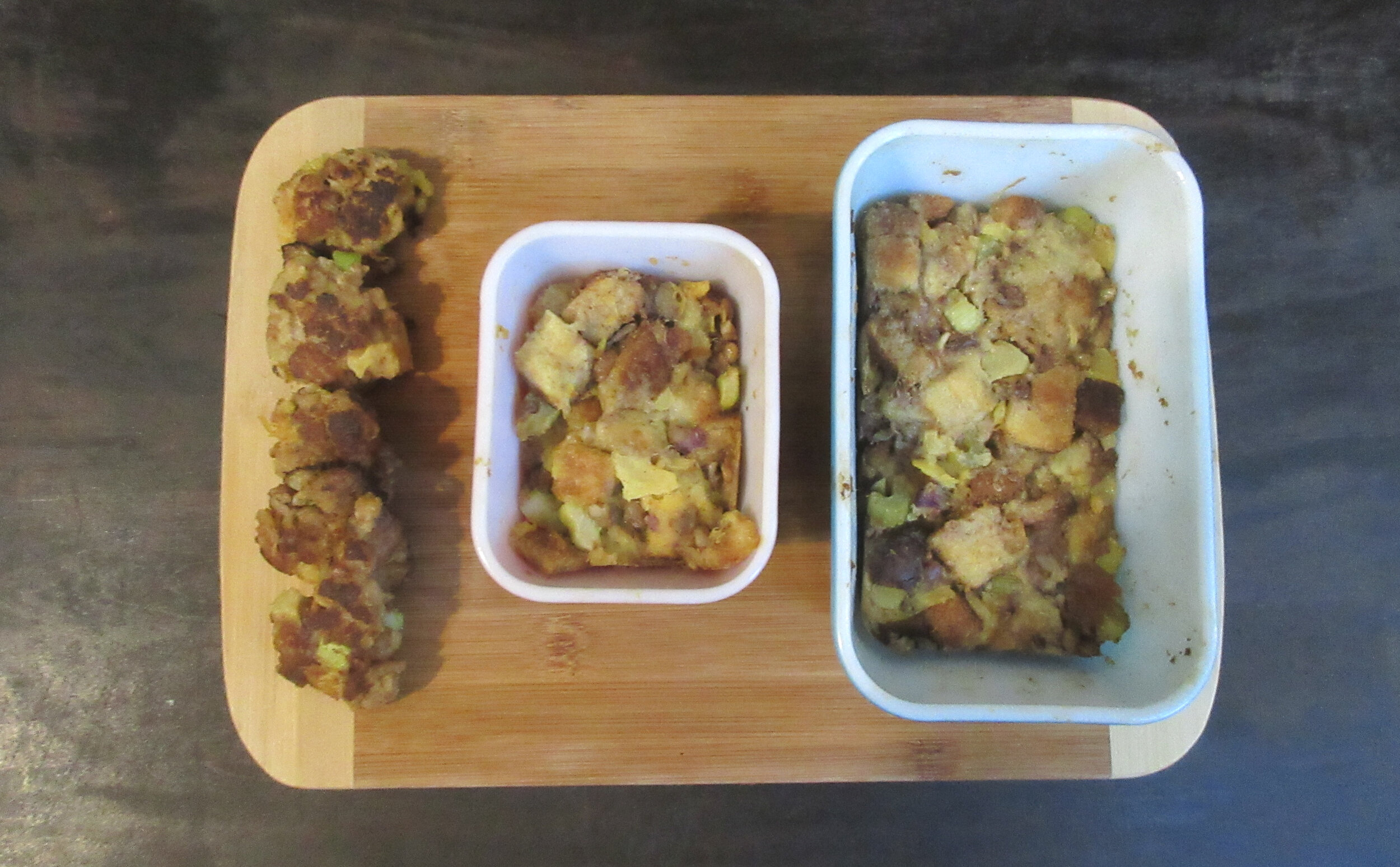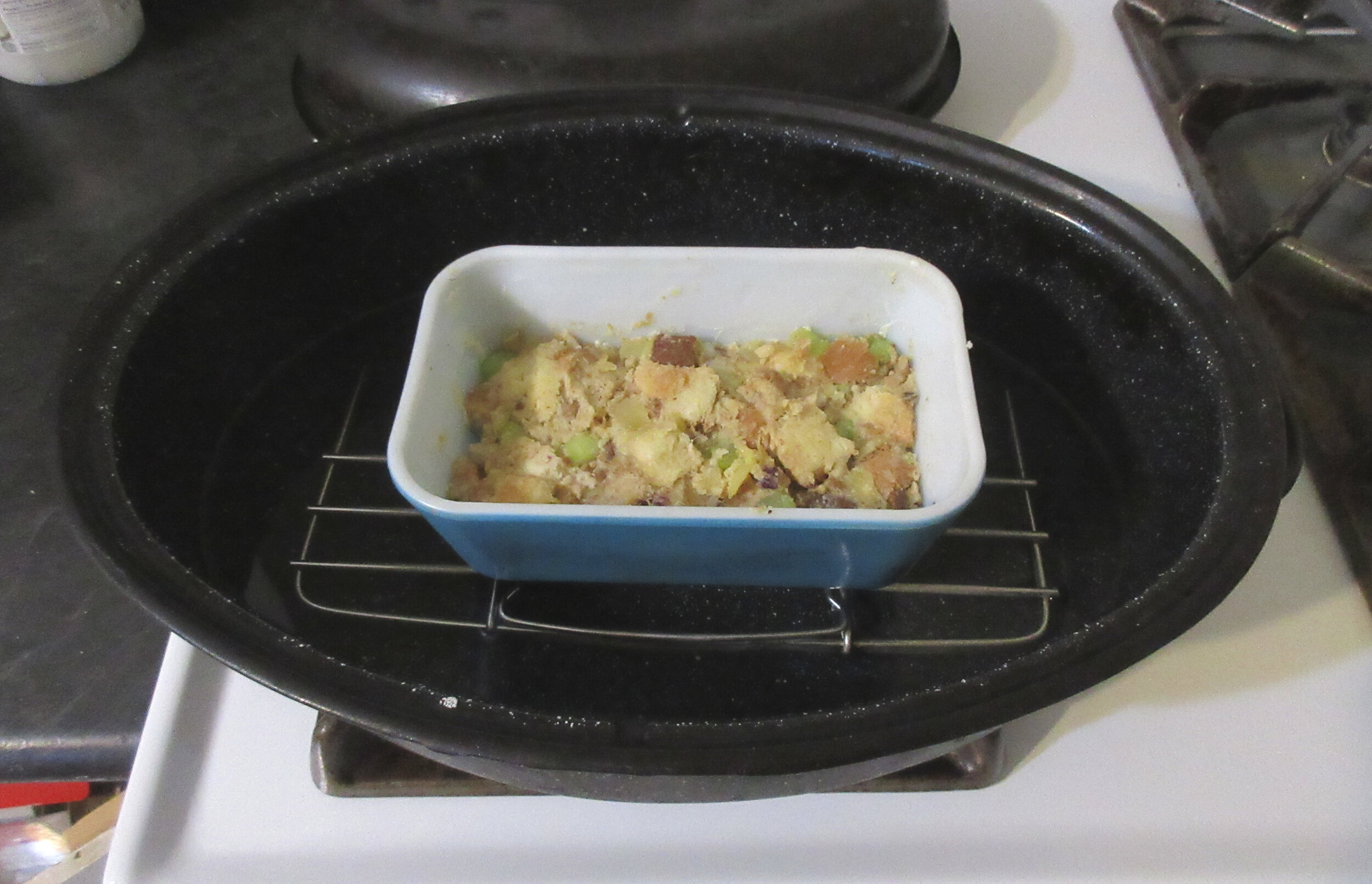Pineapple Nut Stuffing
/ You’ll find this recipe in:
The American Woman’s Cook Book
Edited by: Ruth Berolzheimer
Chicago, 1950
Original Recipe:
PINEAPPLE NUT STUFFING
4 cups dry bread, ½ inch cubes
¾ cup finely chopped celery
½ cup chopped walnuts
¾ cup diced pineapple
1 pimiento, diced
1 teaspoon paprika
Dash cayenne
1 ½ teaspoons salt
¼ cup butter
2 eggs
Combine bread, celery, walnuts, pineapple, pimiento and seasoning. Melt butter, remove from heat, stir in unbeaten eggs and add the bread mixture. Toss lightly. Use as stuffing for turkey, chicken, duck, veal roll, lamb chops or pork chops. Use crisp bacon cut into small pieces instead of nuts, reduce salt one-third and add grated onion, or use red or green bell peppers instead of pimiento. Makes 6 cups.
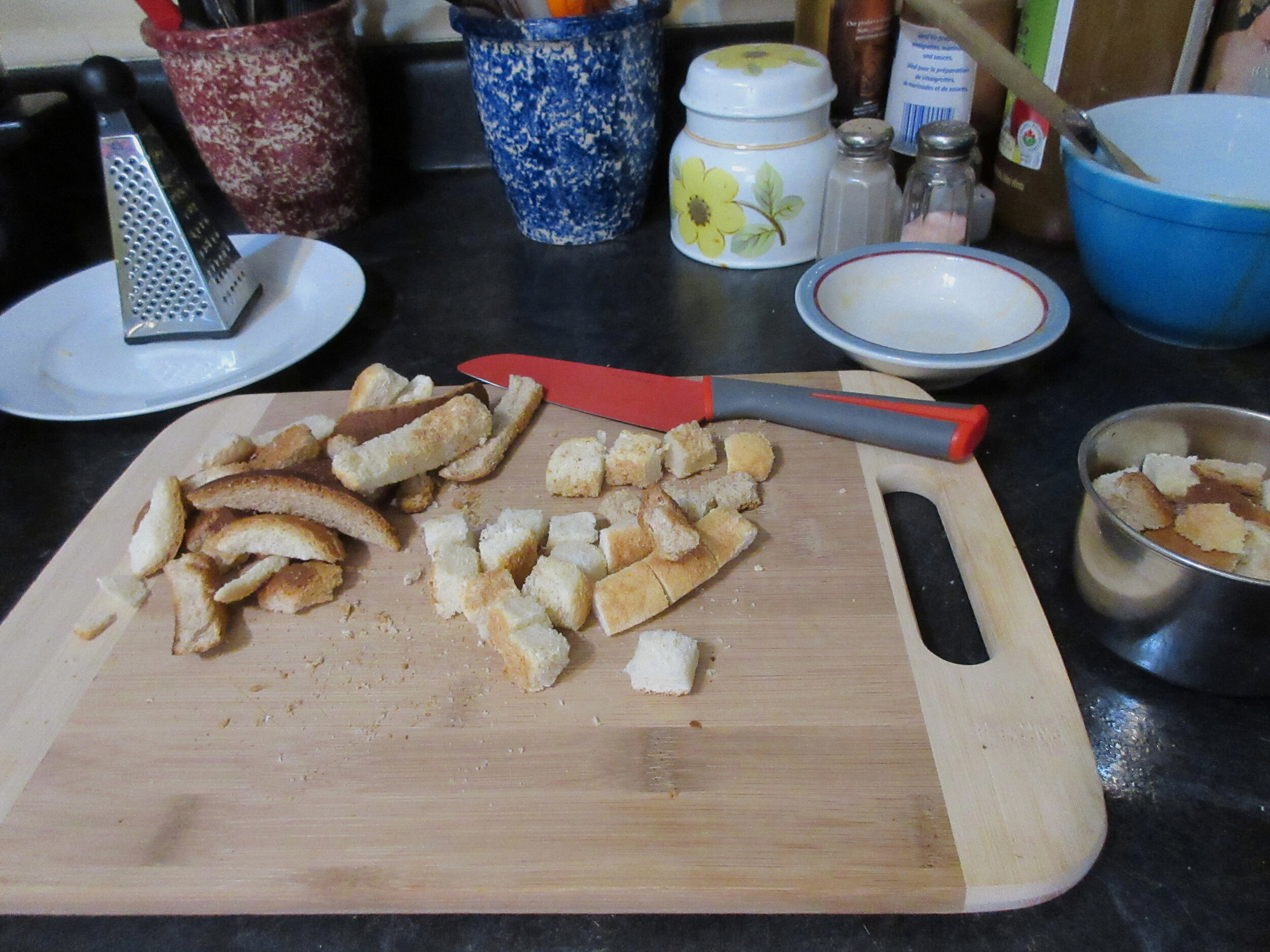

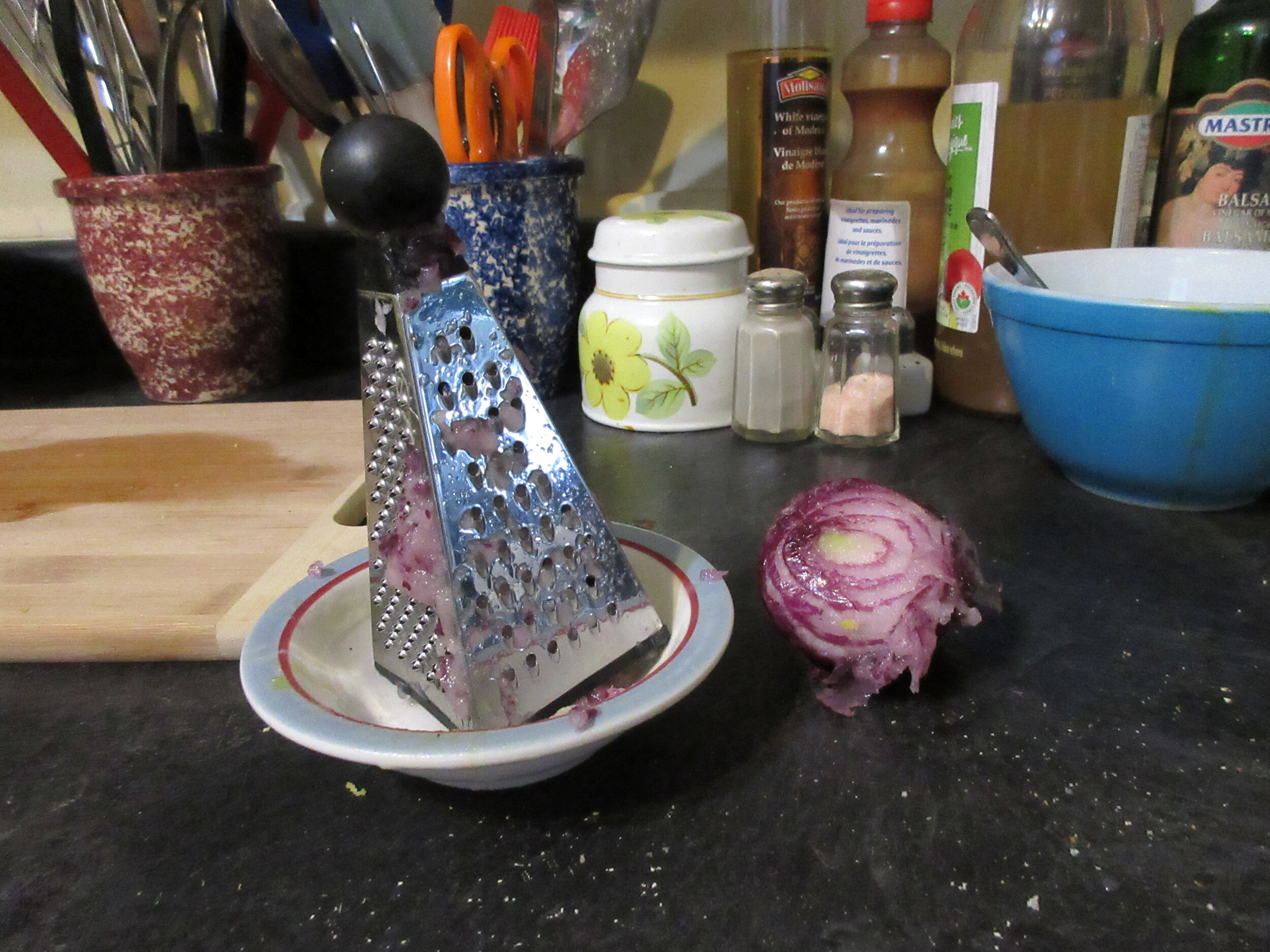

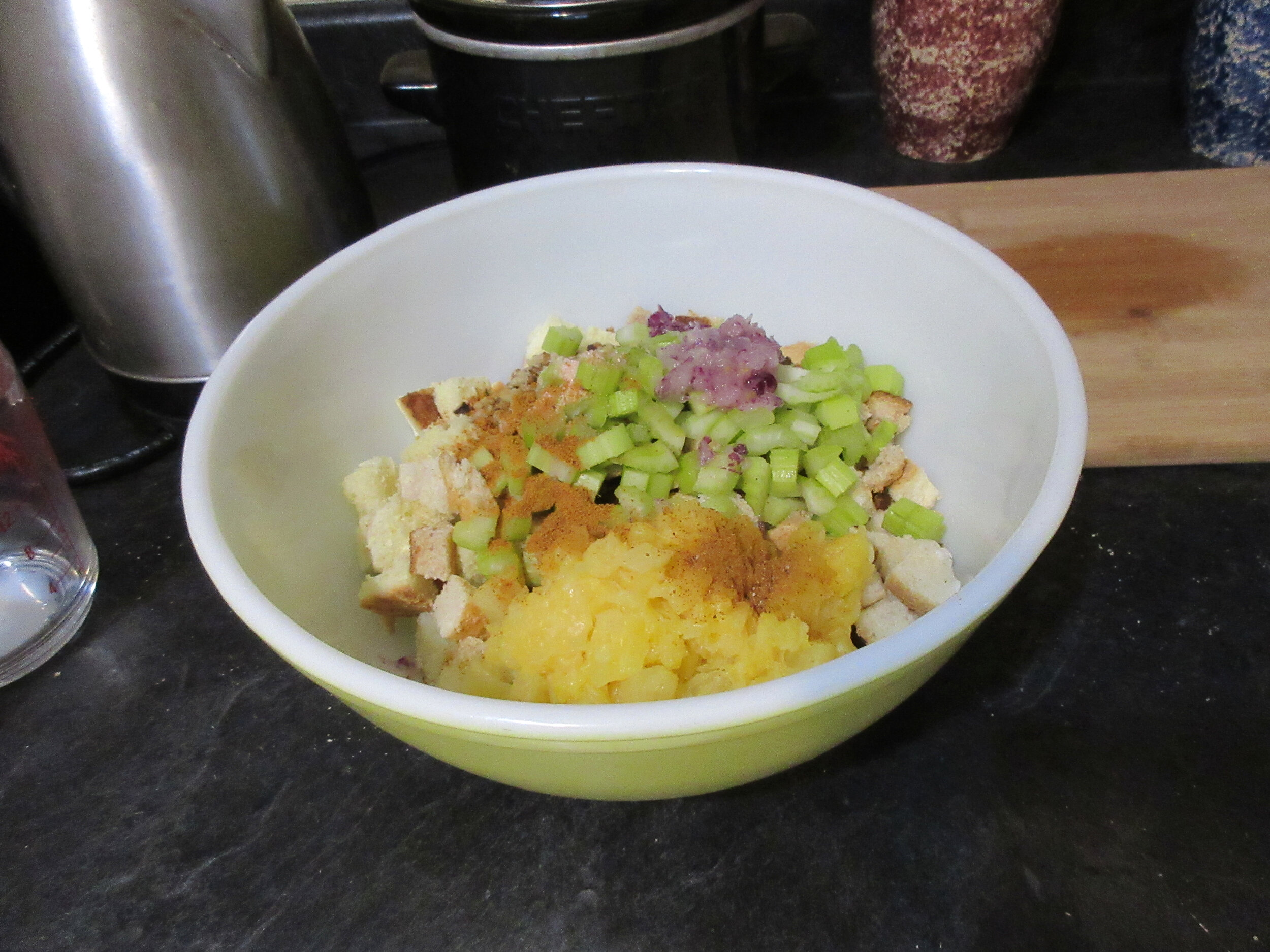
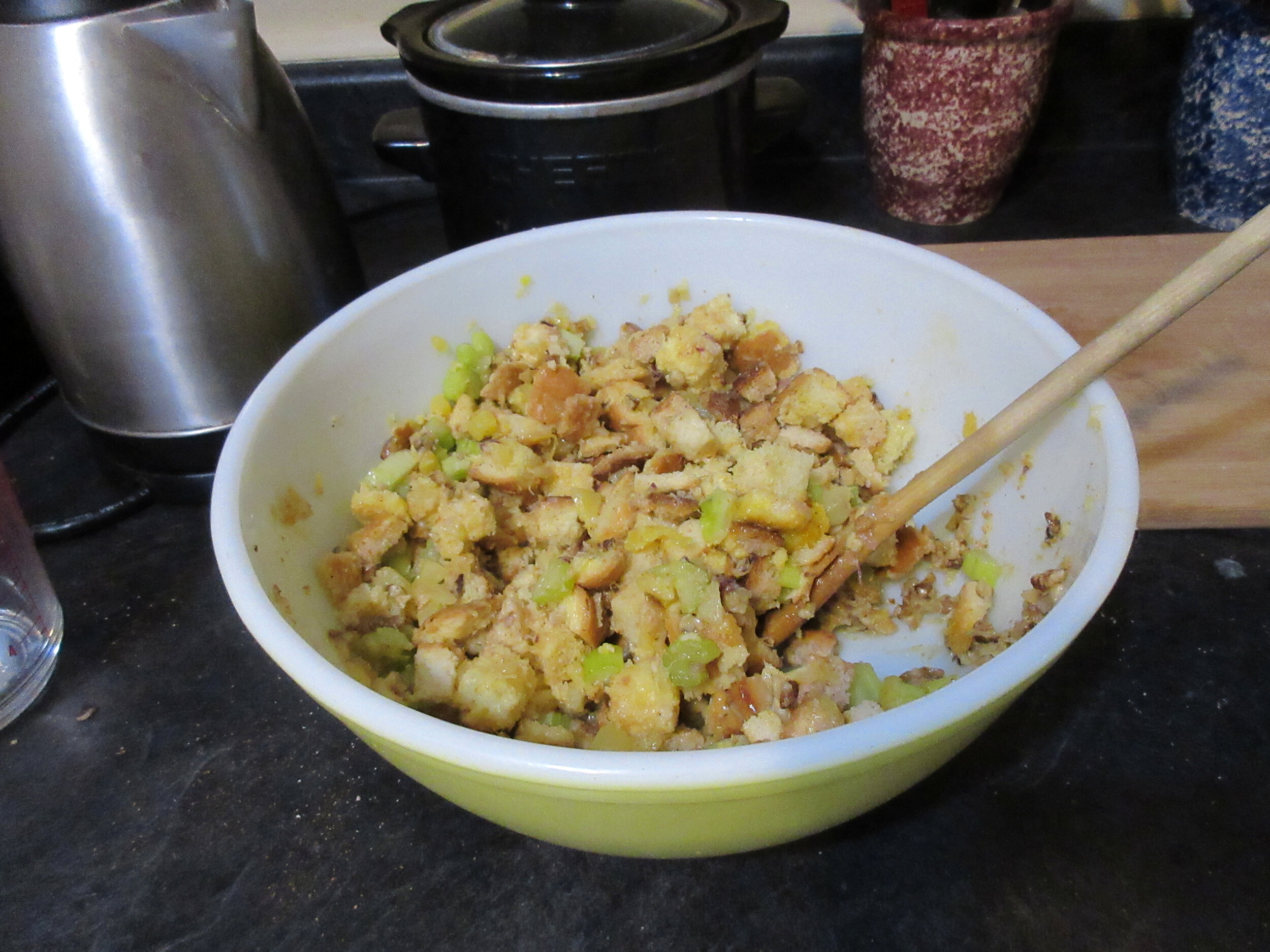
My recipe:
My version of the Pineapple Nut Stuffing recipe is simply the 1950 recipe slightly altered for clarity and with measurements in metric and grams added for those of you not in North America.
4 cups (945 mL) Dry Bread, ½ inch cubes – 200 g
¾ cup (175 mL) Celery, finely chopped – 100 g
½ cup (120 mL) Walnuts, chopped – 50 g
¾ cup (175 mL) Pineapple, diced – 226 g
1 Pimiento, diced
1 teaspoon (5 mL) Paprika
Dash of Cayenne
1 ½ teaspoons (7 ½ mL) Salt
¼ cup (60 mL) Butter – 57 g
2 Eggs
Options: Use crisp bacon cut into small pieces instead of nuts, reduce salt one-third and add grated onion, or use red or green bell peppers instead of pimiento. (I used walnuts, but no bacon, omitted the pimiento & green bell peppers and added 1 tbsp/15 mL grated onion along with only 1 tsp/5mL salt).
Combine bread, celery, walnuts, pineapple, pimiento and seasoning. Melt butter, remove from heat, stir in unbeaten eggs and add the bread mixture. Toss lightly. Makes 6 cups.
Use as stuffing for turkey, chicken, duck, veal roll, lamb chops or pork chops. Or bake, steam or fry the stuffing in croquettes (keep reading for instructions below).
Red: Baked —- Yellow: Ready to be formed into Croquettes & Fried —- Blue: Steamed
Bake, Steam or Fry your Pineapple Nut Stuffing
The introduction to the chapter on Stuffings for Fish, Meat, Poultry and Game lists alternative ways to prepare stuffing, so I decided to try three of the methods listed in this paragraph instead of cooking my stuffing inside of a fowl:
STUFFING does not necessarily have to be baked in the fowl or meat. If the bird is small or there is some stuffing left over, it may be baked or steamed in a well-greased ring mold, loaf pan or individual molds. Fill center of ring with vegetables. Croquettes of stuffing, made by the usual method, are served in a circle around the bird.
As you can see above, I divided my stuffing between two small loaf pans for baking and steaming and left the rest to be formed into croquettes and fried. I don’t have a metal ring mould or a collection of individual moulds, but I definitely would have tried those suggestions if I did. If you prepare this recipe using a mould, send your pictures my way. I’d love to see them!
Croquettes
If you’re short on time, frying the stuffing in croquettes is the fastest of the three preparation methods. Use your hands or spoons to form small croquettes, then fry them in butter until browned on both sides.
Baked
If you choose to bake your Pineapple Nut Stuffing, simply put your pan or mould in the oven. I put roughly 1 cup/235mL in my little loaf pan and I baked it for 30 minutes at 350 F or 175 C.
Steamed
Steamed stuffing will end up with a more moist consistency than baked, similar to if you had cooked the stuffing inside a bird. Your goal is to create a steamy sauna-like environment to cook your stuffing and you can either steam in your oven or on your stove. Since I had my oven on already to bake the other loaf pan of stuffing, that’s how I steamed mine, but I’ll go over the stovetop method as well.
For steaming the pudding in an oven, you’ll need a lidded baking pan. I used a roasting pan and I put a rack underneath my loaf pan. I filled the bottom of the roasting pan with about 1 cm or ½ inch water, put on the lid and popped it in the oven. There was about 2 cups or 470mL of stuffing in my loaf pan, and I steamed it in the oven at 350F/175C for an hour.
You can also steam stuffing in a large lidded pot on your stove. The setup is exactly the same as the oven method: place a rack and about 1 cm or ½ inch of water in the bottom of your pot, set your pan or mould on the rack and put on the lid. Simmer at a low boil.
The end result will probably be more moist than a pudding steamed in the oven and it will probably be done sooner as well. That’s because you’ll have more control over the process on your stove because you’ll be able to check in and make fine adjustments to the temperature. You’ll also want to check in every so often to make sure that the water doesn’t entirely evaporate and top up if needed.
Pineapple Nut Stuffing will probably be the recipe I select the next time I make a Christmas or Thanksgiving turkey. The earthiness of the walnuts and the sharpness of the celery would complement the additional flavour of the turkey juices and the pineapple in the recipe is only perceptible by a slight sweetness. I agree with the suggested variation that bacon would be delicious, either replacing or in addition to the walnuts.
In the pictures below, the croquettes are obviously on the left, but the smaller slice on the blue plate is the baked stuffing and the larger slice was steamed.
It’s not a surprise that croquettes were the tastiest, since they were fried in butter. The baked stuffing was drier than the steamed stuffing, but not in a negative way. It was just different. Depending on how much liquid each bread cube absorbed, it was either or moist or a bit crunchy. The variety of textures was nice. The steamed stuffing had a more universal texture that was similar to stuffing cooked inside of a bird. Had I chosen to steam on the stovetop instead of in the oven, the end result would probably have been more moist and the differences between baked and steamed would probably have been more dramatic.
A big thank you goes to the Plattsville & District Heritage Society that works to preserve the history of the community where I lived for the first 20-odd years of my life. I’ve spent a good portion of my free time since November emptying out the home that belonged to my parents since 1958, which is the main reason why I haven’t made many recipes lately. My Mom constantly saved clippings from newspapers and magazines and was an avid keeper of scrapbooks. Since many of these scrapbooks documented life in her community, many of her scrapbooks have ended up at archives of the Plattsville & District Heritage Society, where my Mom acted as secretary.
I walked into our first donation meeting with a car load of documents, and I walked out with a vintage cookbook in my hand that had been donated, but didn’t match their local focus. I may have eventually made a recipe from The American Woman’s Cook Book from a scanned copy on an online archive, but having a physical copy that I was given on my bookshelf is a big part of why I picked this recipe at this time.
The Plattsville & District Heritage Society is housed in the former Chesterfield United Church, which is the church that I attended as a child. The Society meets regularly and puts on annual exhibits in the summertime in the church’s sanctuary & events throughout the year.
Another thank you goes to “Past Julia” and all the bread that I had stockpiled in my freezer. I had stockpiled frozen bread crusts that I cut off when I made Mushroom Rolls, thinking that I’d make stuffing or bread pudding some day for my blog. I wanted to clear out some space in my freezer and I had so many bread crusts in there that my next recipe also features this frozen bread. However since I made these recipes, I’ve discovered the most effective way to clear out your freezer: just arrange for your freezer to stop working and it will be entirely cleared out!
